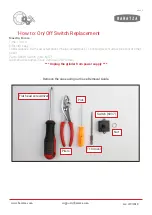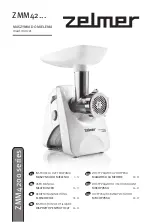
ENGLISH
11
Sanding (fig. 4–7)
WARNING:
:
•
Do not sand metal of any kind with your
polisher. Sparks may be generated by
sanding screws,nails or other metals which
may ignite dust particles.
•
Do not wet sand with this polisher. Liquids
may enter the motor housing and cause
electricshock.
•
Clean out your tool often, especially after
heavy use. Dust and grit containing metal
particlesoften accumulate on interior
surfaces and could create a risk of serious
injury, electric shock or electrocution. Wear
proper ANSI Z87.1 (CAN/CSA Z94.3) eye
protection.
•
When attaching or removing abrasive disc,
use a cloth or glove to protect your hand.
TO ATTACH AN ABRASIVE DISC (FIG. 4, 5)
1. Hold the spindle from rotating by depressing
the spindle lock button (E).
2. Push the hub of the clamp washer (M)
through the center of the sanding (R) and
also through the backing pad (O).
3. Engage the clamp washer threads on the
tool spindle and thread assembly clockwise,
completely down on the spindle.
TO REMOVE AN ABRASIVE DISC (FIG. 6)
Depress the spindle lock button (E) to keep the
spindle from rotating. Turn the disc assembly
counterclockwise to remove the disc.
Sanding (fig. 7)
When using an abrasive disc, hold the tool so that
an angle of 10° to 15° exists between the disc and
the work. If only the outer edge of the sanding disc
is used, a rough cut will result. If the sanding disc is
pressed flat against the work, the sanding action will
be irregular and bumpy, and the tool will be difficult
to control.
Maintenance
Your Black&Decker power tool has been designed
to operate over a long period of time with a
minimum of maintenance. Continuous satisfactory
operation depends upon proper tool care and
regular cleaning.
WARNING:
To reduce the risk of
serious personal injury, turn tool off
and disconnect tool from power
source before making any adjustments
or removing/installing attachments or
accessories. Before reconnecting the
tool, depress and release the trigger
switch to ensure that the tool is off.
Cleaning
WARNING:
Blow dirt and dust out of all
air vents with dry air at least once a week.
Wear proper ANSI Z87.1
(CAN/CSA
Z94.3) eye protection and proper NIOSH/
OSHA/MSHA respiratory protection when
performing this.
WARNING:
Never use solvents or other
harsh chemicals for cleaning the non-
metallic parts of the tool. These chemicals
may weaken the plastic materials used in
these parts. Use a cloth dampened only
with water and mild soap. Never let any
liquid get inside the tool; never immerse
any part of the tool into a liquid.
Lubrication
Black&Decker tools are properly lubricated at the
factory and are ready for use. Tools should be
relubricated regularly every sixty days to six months,
depending on usage. (Tools used constantly on
production or heavy-duty jobs and tools exposed
to heat may require more frequent lubrication.)
This lubrication should only be attempted by
trained power tool repairpersons such as those at
Black&Decker service centers or other authorized
service locations.
Motor Brushes
Be sure tool is unplugged before inspecting brushes.
Carbon brushes should be regularly inspected for
wear. To inspect brushes, unscrew the plastic brush
inspection caps (located in the sides of the motor
housing) and the spring and brush assemblies may
be withdrawn from the tool. Keep brushes clean and
sliding freely in their guides.
CAUTION:
Only use the
Black&Decker
qualified carbon brush designed for
(original instructions)
Summary of Contents for D6138
Page 1: ...D6138 4 13 English original instructions ...
Page 2: ...2 ...
Page 3: ...F D C G A E I E A FIG 1 1 ...
Page 4: ...M N O I E E E O R M FIG 3A FIG 4 3A 4 ...
Page 5: ...10 15 E E FIG 5 FIG 6 FIG 7 5 6 7 ...
Page 24: ...N396621 05 2014 ...










































